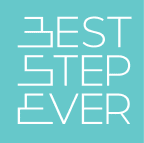Companies need creativity to thrive and stay competitive. Problem is, we often look outside for inspiration when we should be using our powerful internal resources.
Here are five reasons why creativity is essential for business success.

1. It’s vital for future growth
Very few organizations are able to keep making the same product, or providing the same service, without having to make continuous changes to stay relevant.
The only product I can think of that’s remained virtually unchanged is Coca-Cola. Yet, their marketing and sales strategies have had radical changes over the years. As have their back-end production processes.
Most organizations need to reinvent themselves regularly to stay in the game. And to remain profitable. That’s impossible without creativity.
Organizations that learn faster than their competitors are the ones that are good at building long-term business sustainability. The ones that come up with unique ways of doing things. That’s where creativity is essential. Being encouraging of and receptive to creative input is vital for future growth.
And creativity can’t be outsourced to artificial intelligence. It’s an enabler but not the driver. You need living, breathing brains to push the boundaries of what can be done and how it can be done.
2. It’s a precursor to innovation
What is the difference between creativity and innovation?
They are co-dependent. Innovation depends on creativity. Creativity is the front end of a process that ideally will result in innovation. Creativity is the process of developing new and useful ideas while innovation is the successful implementation of those ideas.
Organizations are doomed to fail if they get stuck with tons of creative ideas, but no innovative solutions that result from those ideas.
And that’s where innovation and executional excellence come into play. But without creativity, those innovative solutions are going to stay undiscovered.
3. It makes us work smarter, not harder
Efficiency is doing things right. Effectiveness is doing the right things.
Ever watched an organization working really hard but not making any headway? Chances are they’re spending too much time on the wrong things. And not making enough time to explore how to do things differently.
Creativity is the process of putting imagination to work. It is essential in helping us to find different ways to do the right things better.
Back to that organization. They can’t work their way out of the hole. But if they harnessed some creative minds and set time aside to do some brainstorming, they’re likely to come up with tons of ideas to work smarter and not harder. And that should impact the bottom line very positively in time to come.
4. It builds organizational resilience and flexibility
Did you know that creativity appears in the ten top job skills of the World Economic Forum? It is one of the key skills to manage complexity, develop innovative solutions and build resilience.
An organizational culture which values creativity means that people feel free to provide creative ideas. Executing creative ideas creates change. And when people see change as being positive and happening frequently, they become more resilient and flexible. They see creativity and change as something to welcome and not to fear.
This enabling culture allows people to flourish and make a strong contribution. And it has a positive impact on how the organization changes and grows. As the organization becomes more flexible and resilient, so this becomes the predominant company culture.
5. It encourages experimentation to get better results
Not all creative ideas are good ones. Some flourish and some fail. But the key to having good ideas is to have many ideas. Some will fall by the wayside and some will have significant impact.
And underlying all this is the need to experiment. To feel free to try out new things in the hopes that some will create powerful organizational benefits.
This article describes a fascinating study which found that failure is essential for success. Seem counter-intuitive? Well, over 770 000 grant applications and over 46 years of venture capital start-ups were analyzed to develop a mathematical model to predict the success or failure of an undertaking.
Here are the key findings:
- Every winner begins as a loser.
- People who learnt quickly from their mistakes would eventually succeed.
- The shorter the time between attempts the greater the likelihood of success.
So what matters is how people fail, how they respond to failure and where those failures lead to.
Let’s apply this to organizations. The more times an organization fails in an undertaking, learns quickly from its mistakes and tries again, the quicker the likelihood of increased business success.
And you can’t try different things if you aren’t creative in how you approach the problem.
How to understand and boost creativity.
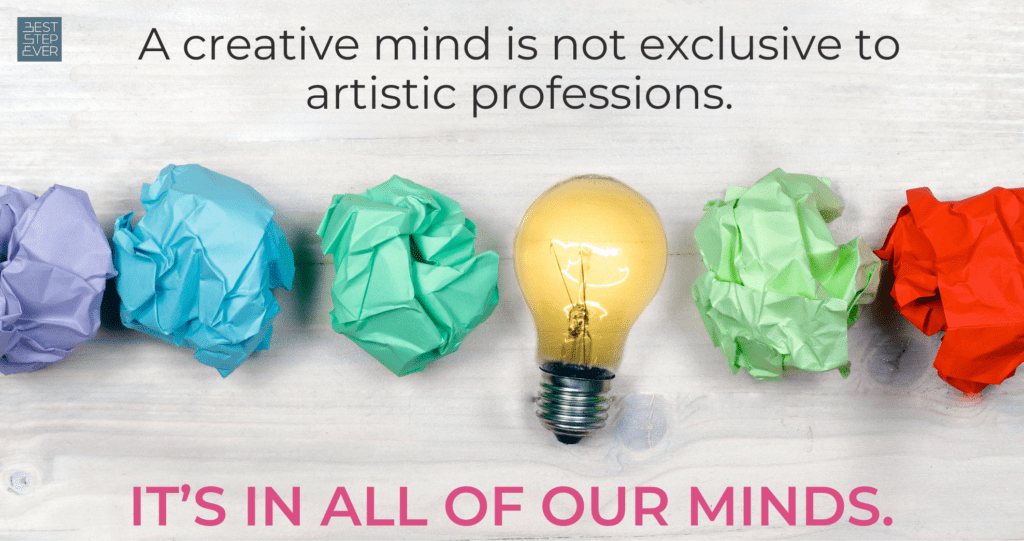
When you think of creativity, what comes to your mind?
Is it:
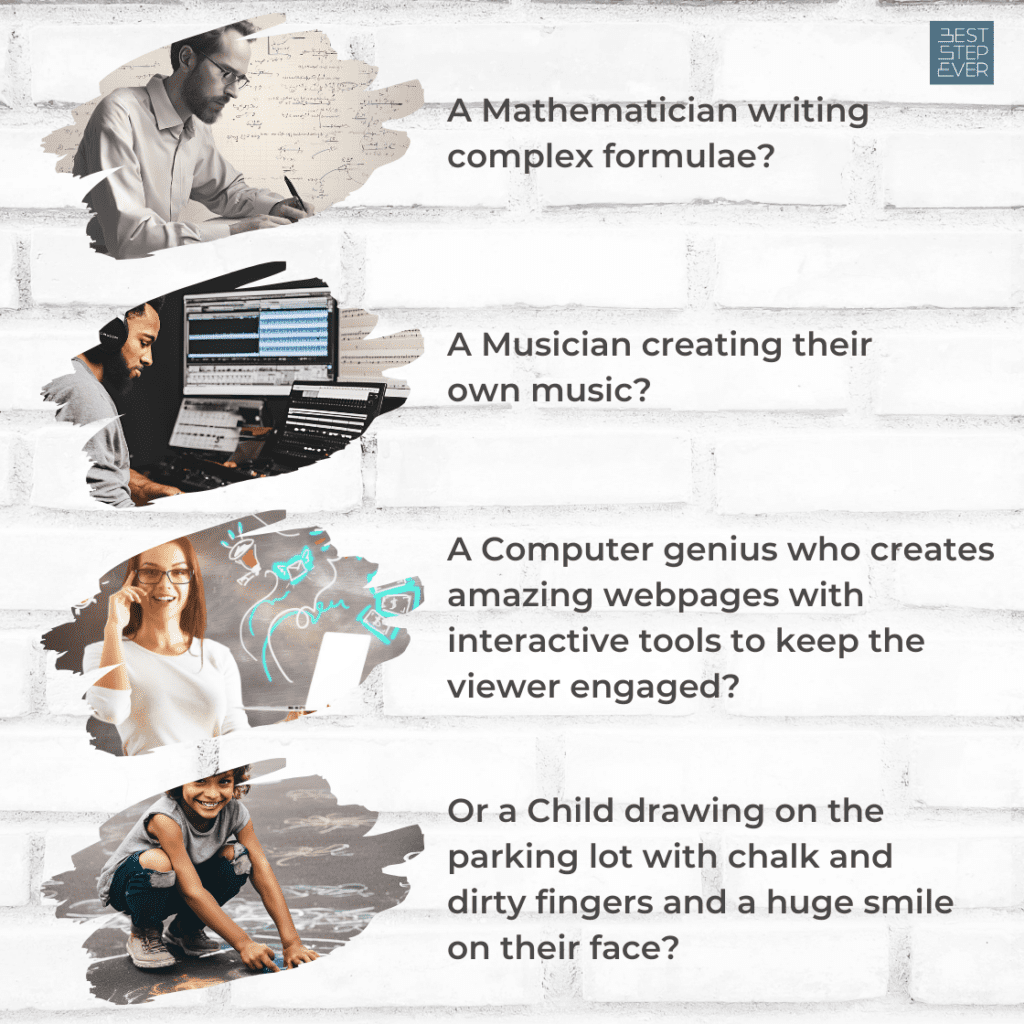
A creative mind is not exclusive to artistic professions. Creativity is in all our minds. The creative thinking process kicks in once we are willing to change our perspective. And fire up our brain activity.
There are many definitions of creativity. Wikipedia tells us that creativity is a phenomenon whereby something new and valuable is formed. But is it really a phenomenon? Or is it a brain function; a process of thinking with the goal of creating an innovative result?
Conventional belief says that the left brain is for analytics and logic, while the right brain is for emotions and creativity. Recent advances in neuroscience however indicate that this simplistic interpretation of the creative process is inaccurate. Scientists now agree that both sides of the brain are key as countless signals go back and forth in the act of creative work.
Research shows that three networks of the brain are associated with creativity. Alison Koonz describes the research work of Bressler and Menon in an accessible way by using the descriptions below.
The Imagination Network (or Default Mode Network) is what we’re activating when we do activities like daydreaming or brainstorming.
The Executive Attention Network is responsible for making decisions and examining the details which drive those decisions. These two networks work together in creativity by developing ideas and then making decisions about the feasibility or otherwise of those ideas.
Watching over both of these functions is the Salience Network. This network filters the stream of information we’re subjected to, and chooses which to allow and which to block. It’s also responsible for switching between the Imagination Network and the Executive Attention network.
So, how does this work in practice? Let’s use our computer nerd as an example. Her imagination (enter the Imagination Network) runs wild as she thinks of ideas about how the website should look and what it should do. The Salience Network then switches on the Executive Attention Network. So that she can hone in on what website functions are more important than others.
All three networks work together to produce what we think of as creative thought.
Are we born with these brain functions or are they learned? Actually, both. All of us have it.
Way back in 1958 George Land found that children are born creative but lose their creativity as they transition through life and into adulthood.
The good news is creativity can be re-learned. Here are some ideas to reawaken your own creativity.
Four ways to spot creative people in your workplace.
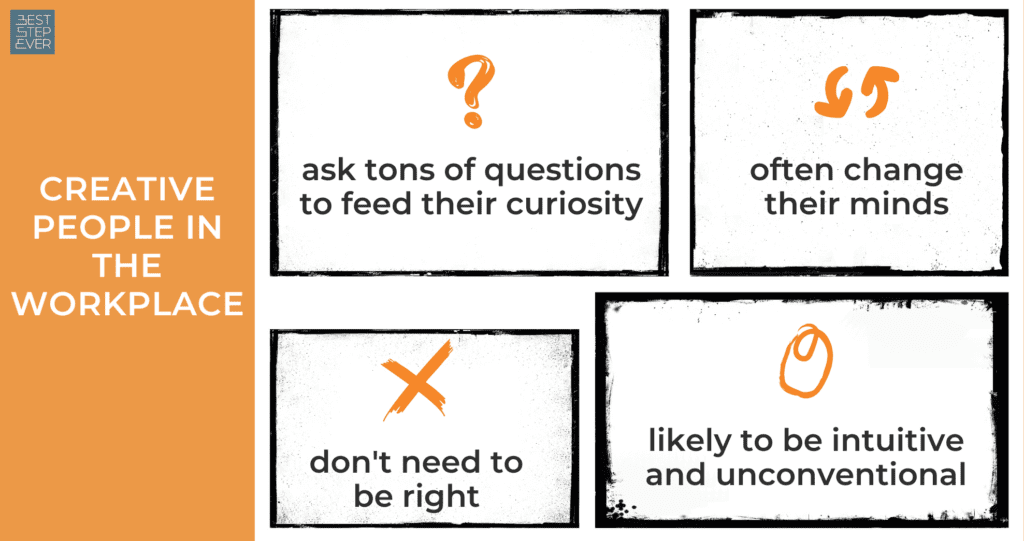
Creativity does not sit within a business process. Creativity sits within people. People who have the capability to find creative ideas make business processes more productive.
Organizations are fond of hiring external companies to do just that.
But how about finding creative people within your own workforce to use your resources smartly? They don’t just sit in your R&D or Marketing team. They sit everywhere in your organization.
How to detect the creatives
Here are a few characteristics of creative people:
1. They ask lots of questions to feed their curiosity
Creative people are intensely inquisitive and often ask questions, very much like children do all the time. Especially the question “why”, followed by “why not?” seems very close to their heart.
They use these questions to understand the issue better and to unlock potential solutions.
They find it easy to challenge the status quo as they often have a good idea of the outcome they want. They may imagine what their goal would look like if it were a reality today. By visualizing it, they become more creative and faster achieve their goal.
2. They often change their mind
Creative people are mostly very willing to change. They recognize that in today’s world the inability to change is fatal.
You might hear them say things like “I changed my mind” or “I am not sure anymore if this is what is right”. It doesn’t bother them to say, “I don’t know.”
They recognize that it is impossible for anyone to know anything about everything. They are very open to different answers and solutions.
3. They don’t need to be right
Creative people generally don’t need to be right. They are more concerned with what’s right rather than who’s right.
They don’t have a hard time to admit when wrong. They don’t burn up their energy to defend themselves.
They are open minded, fluid, flexible and willing to both change their mind and admit that they are wrong.
4. They’re likely to be intuitive and unconventional
Making decisions based on facts and figures is fine for many things.
True creative people however tend to have this sixth sense or gut feeling. They trust their instincts and often come up with highly unconventional or illogical ideas. They like to examine the issue from different perspectives in order to come up with unusual responses.
If you want to find the superpower of creativity within your workforce, you might need to change the lens through which you evaluate people. You may need to start placing more value on the attributes listed above.
There’s a tendency to value people based on performance and potential. Adding a focus on creativity might be your best bet for a sustainable future.
Four places to use creative thinkers in your business for sustainable success.
So, how best to use these creative thinkers?
Well, if you want to benefit as much as possible, you’ll need to create fuzzy boundaries. Discard traditional roles, departments, and hierarchical functions.
These people can be found anywhere in your organization and can be used anywhere.
If you find this concept challenging, time to open yourself up to creative solutions!
1. Creativity in leadership
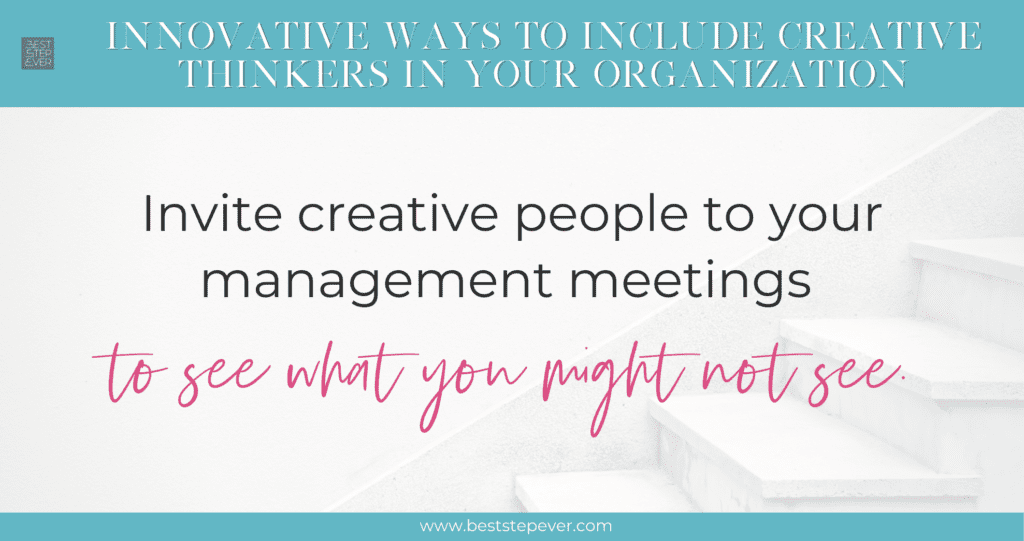
Organizations tend often to exclude the larger workforce from their top management level.
But why not ensure that the voices around the table are more representative of the organization as a whole? That brings different perspectives and much greater creativity into the room.
Your creative fix:
Invite creative people to your top-level management meetings. Present them your problem and provide them with context. Let them add their lens to it. You might be greatly surprised at the amazing ideas their unconventional minds create.
2. Creativity in meetings
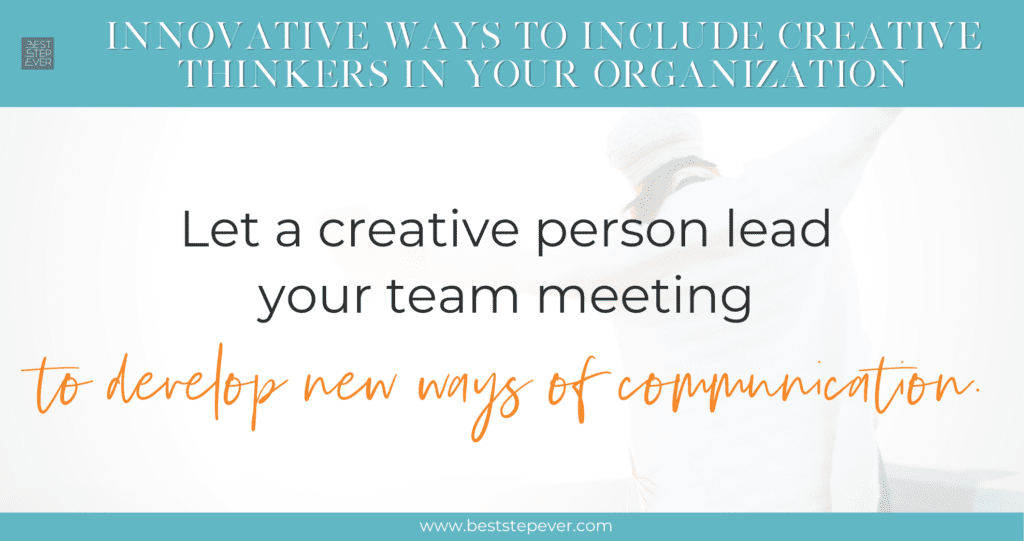
I still remember the day I first saw the TED talk of David JD Phillips on “How to Avoid Death by Powerpoint”. This video was put on Youtube as far back as 2014. Yet still, businesses do the same: daily or weekly death by Powerpoint.
Is your organization still addicted to the use of Powerpoint in your meetings? Simply because the CEO wants it so or because you’ve always done it this way?
Your creative fix:
Let a creative person lead your next team meeting. Provide them with your agenda points. Let them use more creative ways to discuss topics and find more solutions than you yourself can come up with.
3. Creativity in communication
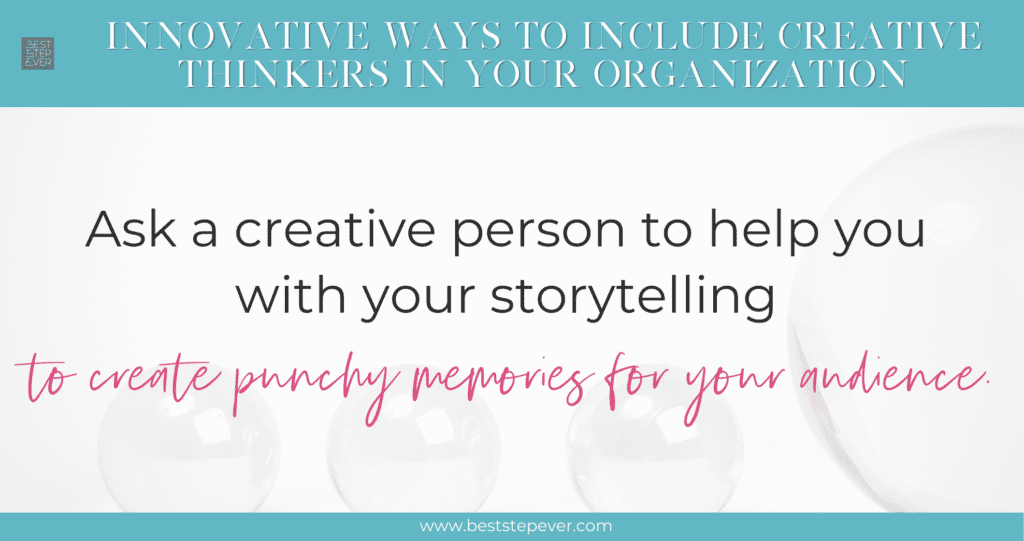
We’re aware that common standards of business communication are a requirement of your corporate identity. Everything looks the same and sounds the same. Words and phrases are repeated to make things stick.
This repetition doesn’t necessarily work, though. It’s not enough to make something memorable.
Here’s a little challenge for you: try to remember the last three Powerpoint decks you’ve seen. How much of them do you really remember?
Your creative fix:
Ask a creative person to help you with your storytelling. People with high creative intelligence are widely known to be imaginative. They will support you in putting a story together that is audience focused and personal. Whilst at the same time using media techniques that the brain will remember.
Even if they might bust your corporate identity from time to time.
4. Creativity in conflict management
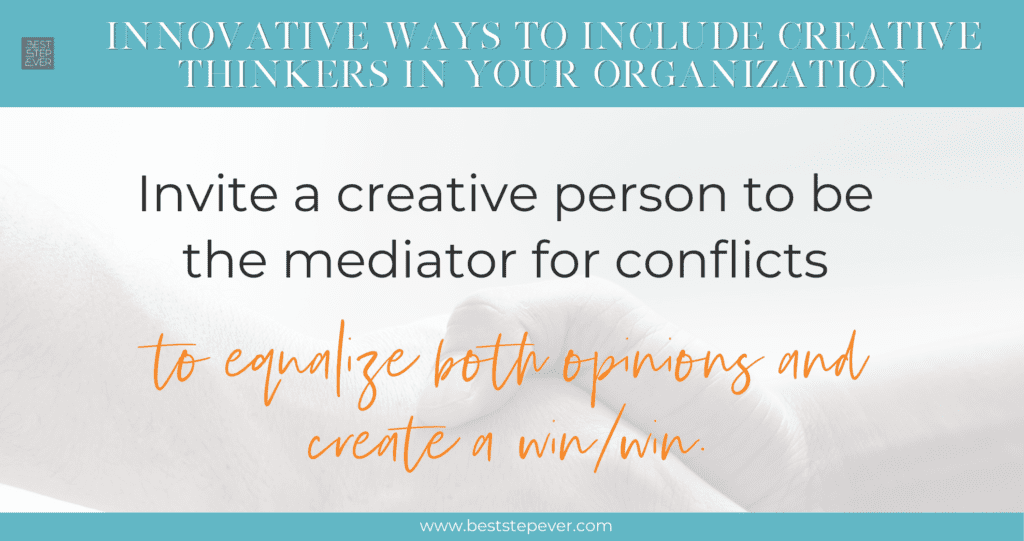
While we still believe that conflict management is part of the leadership or HR role, there is more creative ways to manage conflicts. Not every leader is skilled enough to manage conflicts. Not every HR person is unbiased enough to mitigate.
Your creative fix:
Invite a creative person to be the middleman. As creative people are often not ego driven and are intuitive, they tend to be great non-judgmental mediators with a strong goal focus.
In closing
Inviting creativity in a workplace is often discussed in terms of enabling creativity. Many fantastic ideas can be found online. From designing your office space that inspires creativity to building an inclusive environment. From diversifying your team to encouraging learning from failures.
However, your best resource is learning from the creative people you already have within your organization.
Do you agree? Or what is your best idea to boost creativity?


